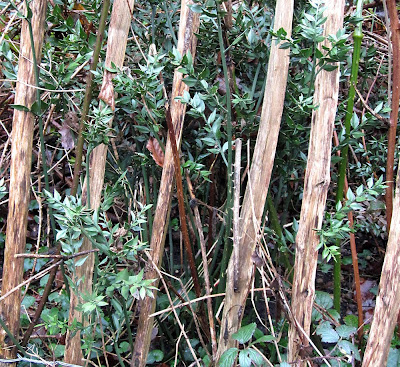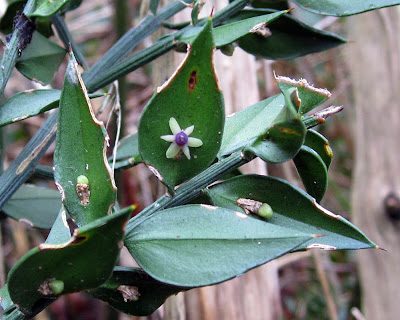 |
| Butcher's Broom growing through a fence at the edge of West Wickham Common |
West Wickham Common has some of those species, though there are other indications that it is not truly ancient. One of those is Butcher's Broom, a small prickly shrub. There are only a few specimens on the common, and in fact most of them are just off the actual common, on private ground, visible over the fence.
Most of these local plants are not very healthy. In fact, its scarcity around here and the poor condition of most of these specimens made me think that Butcher's Broom must be quite rare. (And, of course, it doesn't grow at all in the north of England where I came from.) But then, I read on line that it is widely planted in gardens, is a florist's plant, and is often used in weddings - so there must be a lot in cultivation.
 |
| Butcher's Broom in flower at the edge of West Wickham Common |
The plant in the top photo is one of the best in West Wickham, and you can see it is actually growing through the fence. It likes shade and grows under trees where you will not find many other shrubs, except perhaps holly.
Butcher's Broom is a real oddity. It doesn't have actual leaves; instead, specalised branches called cladodes or cladophylls are flat and leaf-shaped. You can tell they are not true leaves because the flowers grow directly from them; flowers always grow from stems or branches, never from leaves.
This is a female plant. The photo on the right shows a flower, and the lower photo shows a juicy-looking red fruit. These grow from the undersides of the cladodes.
 |
| Butcher's Broom in fruit at the edge of West Wickham Common |
The stiff and spiny cladodes are supposed to be difficult for animals to eat, but something clearly loves these. Nearly all of them have been nibbled, and the fruit also has some damage. But these fruits are big, red and shiny to attract birds, which spread the seeds, so a damaged fruit is no problem for the plant.
These flowers and fruit are both on the plant at the same time; late February.
No comments:
Post a Comment